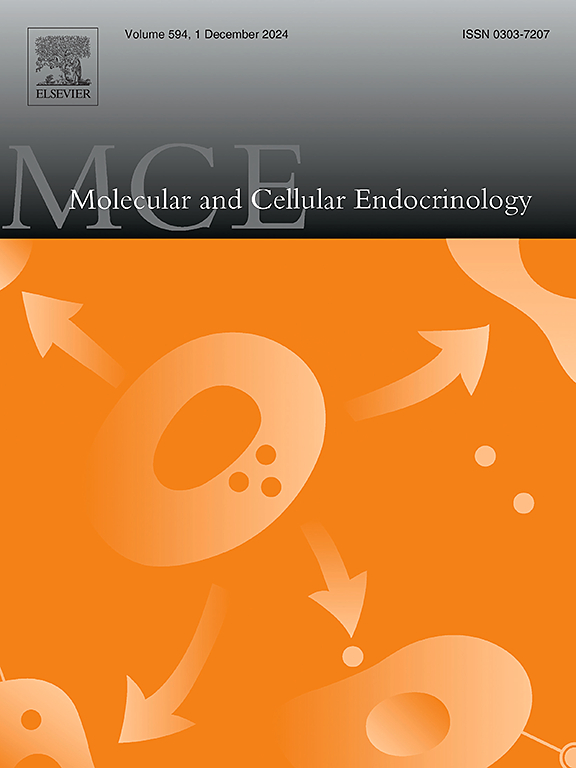Identification of puberty related miRNAs in the hypothalamus of female mice
IF 3.8
3区 医学
Q2 CELL BIOLOGY
引用次数: 0
Abstract
Background and aims
Puberty is a crucial developmental stage marked by the transition from childhood to adulthood, organized by complex hormonal signaling within the neuroendocrine system. The hypothalamus, a central region in this system, regulates pubertal functions through the hypothalamic-pituitary-gonadal (HPG) axis. Gonadotropin-releasing hormone (GnRH) neurons, essential in puberty control, release GnRH in a pulsatile manner, initiating the production of sex hormones. Major influence in pubertal timing has been attributed to genetic predisposition, environmental factors, and nutritional status. MicroRNAs (miRNAs), small non-coding RNA molecules, have emerged as key regulators in various cellular processes by either repressing genes or activating them by inhibiting their repressors. The present study aims to investigate the involvement of miRNAs in the control of puberty.
Methods
Small RNA sequencing was used to identify and compare the total population of miRNAs in the hypothalamus of female mice before, during and after puberty. Bioinformatic analysis was applied to analyse the expression profile of miRNAs with altered levels followed by pathway enrichment analysis.
Results
Expression levels of several miRNAs were found up- or down-regulated from pre-pubertal to pubertal stage. Furthermore, monitoring the levels of these miRNAs at the post-pubertal stage revealed four expression patterns, in which pathway analysis displayed the associations of these miRNAs with developmental processes, cell cycle regulation, metabolic biosynthesis and epigenetic regulation.
Conclusion
The findings of the present study improve our understanding of the molecular pathways underlying puberty and stress the significance of miRNAs in fine-tuning gene expression within the hypothalamus during this critical developmental stage.
雌性小鼠下丘脑青春期相关mirna的鉴定。
背景和目的:青春期是一个重要的发育阶段,标志着从童年到成年的过渡,由神经内分泌系统内复杂的激素信号组织。下丘脑是该系统的中心区域,通过下丘脑-垂体-性腺(HPG)轴调节青春期功能。促性腺激素释放激素(GnRH)神经元在青春期控制中至关重要,以脉动的方式释放GnRH,启动性激素的产生。青春期时间的主要影响因素是遗传易感性、环境因素和营养状况。MicroRNAs (miRNAs)是一种小的非编码RNA分子,通过抑制基因或通过抑制它们的阻遏物来激活它们,在各种细胞过程中成为关键的调节剂。本研究旨在探讨mirna在青春期控制中的作用。方法:采用小RNA测序技术,对雌性小鼠青春期前、青春期中、青春期后下丘脑mirna的总数进行鉴定和比较。应用生物信息学分析分析mirna表达谱,然后进行途径富集分析。结果:从青春期前期到青春期阶段,几种mirna的表达水平上调或下调。此外,在青春期后监测这些mirna的水平揭示了四种表达模式,其中通路分析显示这些mirna与发育过程、细胞周期调节、代谢生物合成和表观遗传调控相关。结论:本研究的发现提高了我们对青春期分子通路的理解,并强调了mirna在下丘脑这个关键发育阶段微调基因表达的重要性。
本文章由计算机程序翻译,如有差异,请以英文原文为准。
求助全文
约1分钟内获得全文
求助全文
来源期刊

Molecular and Cellular Endocrinology
医学-内分泌学与代谢
CiteScore
9.00
自引率
2.40%
发文量
174
审稿时长
42 days
期刊介绍:
Molecular and Cellular Endocrinology was established in 1974 to meet the demand for integrated publication on all aspects related to the genetic and biochemical effects, synthesis and secretions of extracellular signals (hormones, neurotransmitters, etc.) and to the understanding of cellular regulatory mechanisms involved in hormonal control.
 求助内容:
求助内容: 应助结果提醒方式:
应助结果提醒方式:


